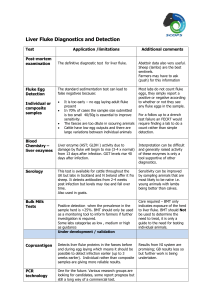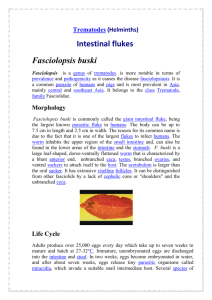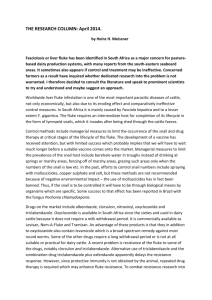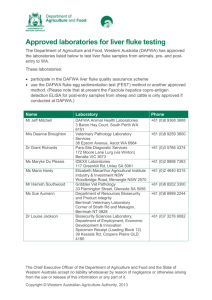Trematodes (Flukes): Intestinal & Blood Flukes Presentation
advertisement
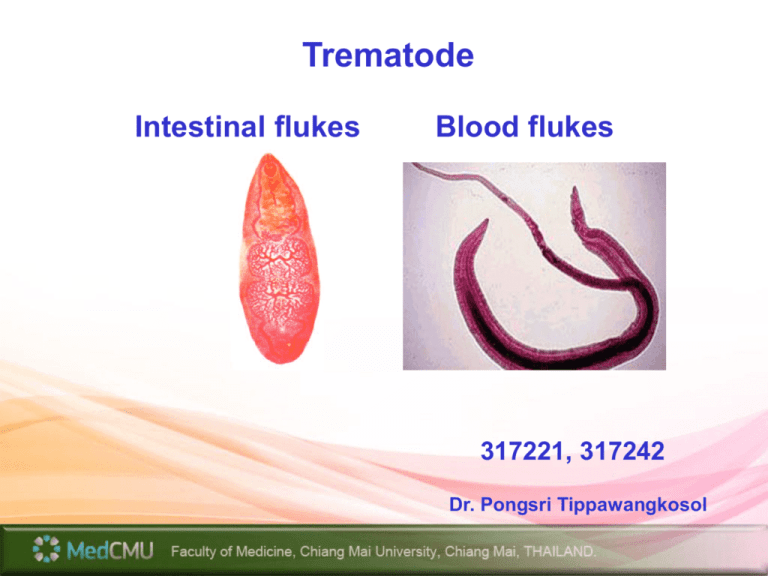
Trematode Intestinal flukes Blood flukes 317221, 317242 Dr. Pongsri Tippawangkosol Cestode (Tapeworm) Trematode (Fluke) Helminths Nematode (Round worm) Phylum nematoda Roundworm Class Phasmidia - Ascaris lumbricoides - Enterobius vermicularis - Gnathostoma spinigerum - Angiostrongylus cantonensis - Necator americanus - Ancylostoma duodenale - Wuchereria bancrofti - Brugia malayi Class Aphasmidia - Trichinella spiralis - Trichuris trichiura - Capillaria phillipinensis Phylum Platyhelminthes Trematoda (flukes) Lung flukes - Paragonimus spp. Liver flukes - Clonorchis spp. - Opisthrochis spp. - Fasciola spp.(ใบไม้ตบั ) - Dicrocoelium spp. - Eurytrema Intestinal flukes - Fasciolopsis buski - Echinostoma spp. - Heterophyes spp. - Haplochis taichui Blood flukes - Schistosoma spp. Cestoda (tapeworms) Order Pseudophyllidea - Dipyllobothrium latum (ตืดปลา) - Spirometra spp. (ตืดสุ นขั ) Order cyclophyllidea - Dipylidium caninum (dog tapeworm) - Hymenolepis nana (dwarf tapeworm) - Hymenolepis diminuta (rat tapeworm) - Taenia solium (pork tapeworm) - Taenia saginata (beef tapeworm) - Echinococcus spp. (dog tapeworm) - Multiceps multiceps (dog tapeworm) Trematode (Fluke) Lung fluke Liver fluke Intestinal fluke Blood fluke Complex life cycle 1st intermediate host 2nd intermediate hosts: depend on species 1 st intermediate host 2 nd intermediate host Lung fluke - Liver fluke (Fasciola spp.) - Intestinal fluke (F. buski) - Liver fluke (O. viverrini) - Intestinal fluke (H. taichui) Development Adult (human) (ingestion) egg miracidium in water sporocyst in snail Blood fluke (penetration) 1st intermediate host redia in snail cercaria in snail metacercaria in 2nd intermediate host (crab, shrimp, fish, water plant) Are there any parasites in these menu ?? Papaya salad Raw fish pricked fish ส preserved fish Vegetable (water plant) H. taichui Liver flukes Intestinal fluke (1 mm.) Lung fluke Liver fluke 5-8 cm. Intestinal fluke Intestinal flukes Large size : Fasciolopsis buski Small size : Haplorchis taichui Adult worms live in small intestine Blood flukes : Schistosoma spp. Adult worms live in blood vessels in intestine or bladder Intestinal flukes Fasciolopsis buski Haplorchis taichui Large intestinal fluke, 5-8 cm. Small intestinal fluke, 1 mm. Are there any parasites in water plant ?? Water caltrop Water chestnut Morning glory Lotus Water mimosa The largest intestinal fluke : Fasciolopsis buski Disease : Fasciolopsiasis - Infection 10 million/year - Thailand, India, China, Loa, Vietnam, Cambodia, Indonesia, Malaysia, Korea Larva develop in snail Eat fresh water plant Development Adult (Small intestine) Eat Egg passed in feces Larva developed in snail Metacercaria in water plant Adult : size 2-7 cm. long Unbranched intestine Uterus 1 Ovary (branch) 2 Testes (Branch) Egg : large size 130x80 um Small operculum Oval shaped with thin shell Unembryonated egg The egg is similar as liver fluke egg (Fasciola spp.) Symptoms Attachment of large worms to the mucosal of small intestine Mild infection Inflammation of mucosa Hemorrhage Ulcerlation Symptoms Heavy infection (100-10,000 worms) Abdominal pain Chronic diarrhea - Decrease absorption of Vit B12 - Intestinal edema (absorption of worm toxin) - Allergy and can cause death Diagnosis Stool examination to find egg Prevention - Be careful to eat raw fresh water plants - Wash vegetable - Heat can kill flukes Are there any parasites in fresh water fish ?? “Eat raw fish” Pla som Koi pla Pla ra Jaew bhong Minute or small intestinal fluke : Haplorchis taichui Haplorchiasis Southeast Asia Thailand, Loa, Vietnam, Cambodia, Philippines Development Adult live in small intestine Eat Egg passed in feces Larva develop in snail Metacercaria in fresh water fish - Small size (1 mm.) - Flat elongate cover with spines Haplorchis taichui ข 1 Ovary 1 testis Ventral sucker Surrounded by fan shaped hooklet (13-16 hooklets) Egg operculum shoulder - Small size - Oval shaped - Embryonated egg miracidium (egg contain miracidium inside) knob Egg is similar as liver fluke egg (Opisthorchis viverrini) Symptoms diarrhea Abdominal pain Diagnosis Prevention Do not eat raw or uncooked fish Stool examination to find egg Are there any parasites in water ?? Contact the water in Africa, south America, India, SEA How dose Blood fluke enter to human ? Skin penetration Cercarial dermatitis Hepatosplenomegaly Blood fluke (Schistosome) Disease : Bilhaziasis or Schistosomiasis What is the importance of blood fluke ? Epidemiology - Infect 200 million people/year throughout the world - 76 countries (85% in Africa) - Died 200,000/ year - No case in Thailand How many human blood fluke ? 1. Schistosoma mansoni (South America) 2. S. haematobium (Africa, India) 3. S. japonicum (Southeast Asia) 4. S. mekongi (Southeast Asia) 5. S. intercalatum (Africa) Intestinal schistosomiasis Adult live in blood vessels in large intestine (S. mansoni) Adult live in blood Vessel in small intestine S. japonicum S. makongi S. intercalatum Urinary schistosomiasis Adult live in blood vessels in bladder S. haematobium Adult live in blood vessels in small intestine, large intestine, urinary bladder Fork-tailed cercaria penetrated the skin Urinate or defecated in the water Egg passed in feces or urine Fork-tailed cercaria Larva developed in snail Development Adult (vessels in small intestine, large intestine, bladder) egg passed in feces or uine sporocyst larva develop in snail Penetrate skin Fork-tailed cercaria in water Skin circulation Lung Liver intestine or bladder Cercaria (schistosomule) (adult) Fork-tailed cercaria (infective stage) Where is blood fluke ? Adult live in human Larva live in water First intermediate host Bolinus spp. in S. haematobium Biomphalaria spp. in S. mansoni Oncomelania spp. in S. japonicum Tricula aperta in S. mekongi Blood flukes (Schistosoma spp.) sex separate male has gynecophoric canal for female live inside infective stage is fork-tailed cercaria no larva stage (redia and metacercaria) egg without operculum egg with miracidium inside (embryonated egg) egg with spine or knob Female (2 cm. x 0.3 mm.) Testis - Sex separate - Male has many testes - Male carries the female in the gynecophoric canal - Has reunion intestine Male (1 cm. x 1 mm.) Ovary Oral sucker Male Oral sucker Ventral sucker Ventral sucker Female Gynecophoric canal - Oval shaped with spine or knob - Egg without operculum - Embryonated egg contains miracidium How does blood fluke develop symptoms ? Nudules in liver & brain Eggs go back into liver & brain Adult live in blood vessels in small intestine, large intestine, urinary bladder Female lay eggs Many eggs invade in tissues Nudules in intestines & bladder Bloody urine, bloody stool How does blood fluke cause symptoms ? 1. Penetration of cercaria cause dermatitis 2. Migration of schistosomulae (larva) to lung cause inflammation 3. Egg deposit in intestine or bladder cause trauma & haemorrhage 4. WBC & fibroblast infiltration around eggs cause small fibrous nodule in the intestine or bladder 5. Many eggs go back into the liver the process followed No. 4 cause many nodules in liver (Cirrhosis, hepatospleenomegaly) Bladder Brain Eggs cause nodules in small intestine, large intestine, spleen, bladder, brain Eggs in brain Nodules in bladder Nodule in small intestine Hepatosplenomegaly caused by many eggs from small intestine & large intestine go back into portal vein to the liver What are symptoms caused by blood flukes ? Itching & rash (swimmer’s itch) Fever, diarrhea, abdominal pain Bloody urine (hematuria) Bloody stool Cirrhosis, Hepatosplenomegaly Bladder cancer, colon cancer Coma (nodules in brain) Symptoms Urinary schistosomiasis (S. haematobium) - Bloody urine (haematuria), RBC in urine - Obstruction of urinary system - Kidney failure, bladder cancer Intestinal schistosomiasis (S. mansoni, S. japonicum, S. makongi) - Bloody stool , abdominal pain, nodules in intestine - Hepatosplenomegaly (egg go back to liver) - Coma, paralysis (egg go back to the brain) - Colon cancer How to diagnose ? 1. Stool or urine examination to find egg 2. Tissue biopsy (rectal or liver) to find egg 3. Blood examination to find antigen or antibody Egg of S. mansoni by rectal biopsy How to prevent & control blood fluke ? Snail control spraying Treatment Single oral dose of praziquantel Avoid enter to endemic area Rapid treatment of patient Hygienic education feeding Lung fluke Liver fluke Intestinal fluke Blood fluke Intestinal flukes Large size Fasiolopsis buski Egg 2nd intermediate host Adult Small size Haplorchis taichui Adult Egg 2nd intermediate host Blood flukes Schistosoma spp. Adult egg fork-tailed cercaria Preserved fish - liver fluke (O. viverrini) - small intestinal fluke (Haplorchis taichui) Water plant Pickled water crab lung fluke Paragonimus spp. - large intestinal fluke (Fasiolopsis buski) - liver fluke (Fasciola spp.) Animal Schistosome S. spindale (cattle and water buffalo) S. bovis (cattle, sheep, goats) Orientobiharzia harinasutai (water buffalo) S. incognitum (dog, pig, rat) Trichobiharzia ocellata (duck) Gigantobiharzia spp. (birds) Skin penetration by animal cercaria Severe rash Swimmer’s itch Schistosome cercarial dermatitis Skin penetration
